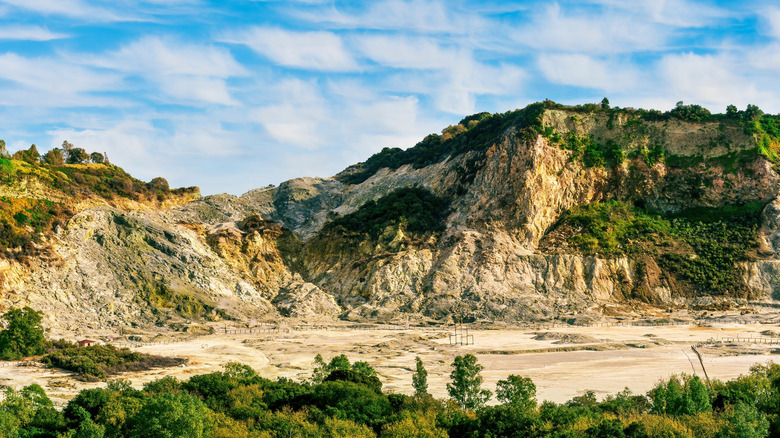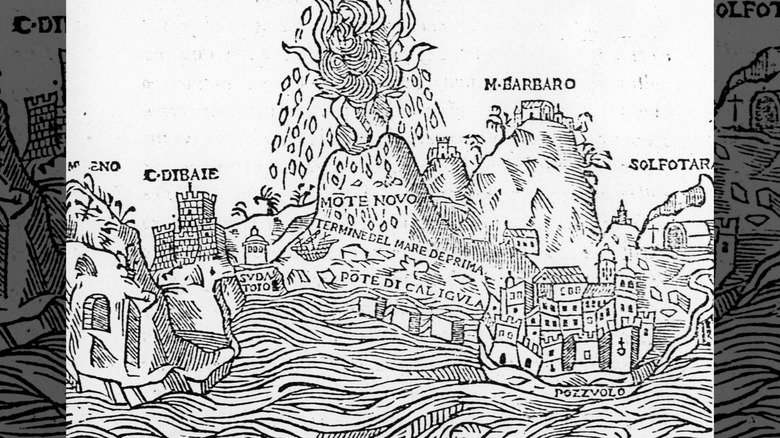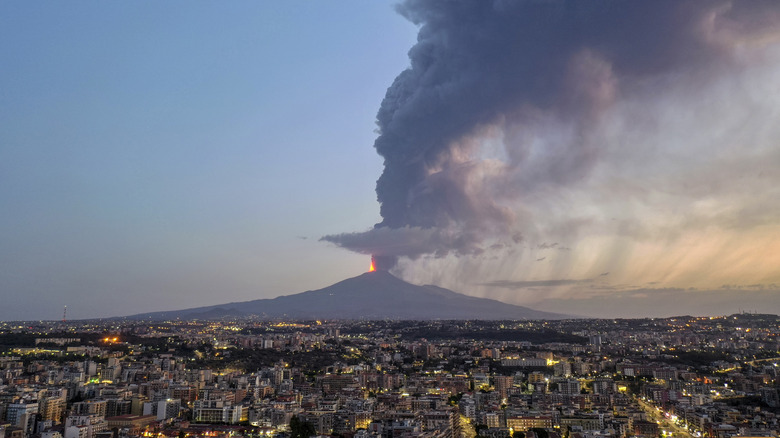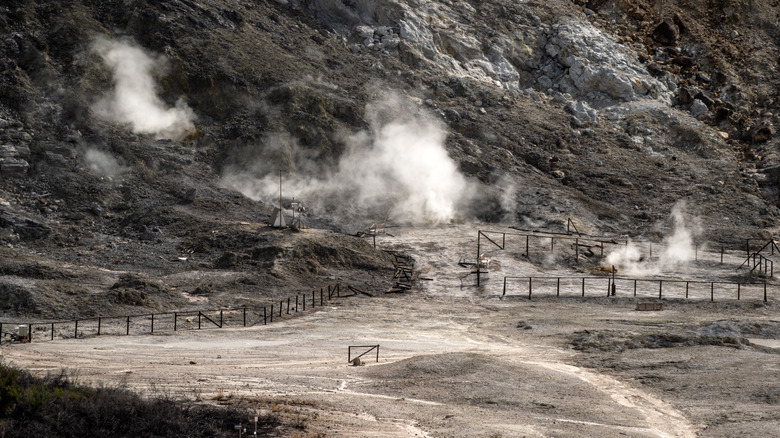Europe's Supervolcano Is A Ticking Timebomb
The Earth is ever restless. Deep beneath the ground there are oceans of magma powering some of the most relentless and unpredictable natural phenomena like earthquakes and volcanoes. Most of the power of the Earth is concentrated around the boundaries of endlessly shifting tectonic plates, such as the Ring of Fire that encircles the Pacific Ocean, and indeed, it is at these tectonic fault lines where most of the world's earthquakes occur and where the majority of its volcanoes form. One of these boundaries is located in the Mediterranean, where the collision between the African and Eurasian tectonic plates has produced some seriously destructive volcanic activity.
You've probably heard of Mount Vesuvius. It's the one that destroyed the ancient Roman cities of Pompei and Herculaneum nearly 2,000 years ago. It's also considered one of the most dangerous volcanoes in the world due to its volatility and proximity to the heavily populated city of Naples, Italy. But unknown to many, there is actually a larger, more dangerous volcano sleeping in Vesuvius' shadow.
Fifty miles west of Mount Vesuvius lies Campi Flegrei, or the Burning Fields. Unlike Vesuvius, which looks like a volcano, Campi Flegrei is actually a group of volcanoes, some of which are underwater, evidenced only by the craters left behind from past eruptions. And if Campi Flegrei unleashes its full power, it could be a natural disaster the likes of which Europe has never seen.
What happens if Campi Flegrei erupts?
To understand the destructive potential of Campi Flegrei, one only has to look to the past. Its last major eruption occurred in 1538 and was powerful enough to create a new landmark, Monte Nuovo, a hill some 400 feet tall. The first signs of the eruption were swarms of earthquakes and the uplift of land that had been sinking for centuries. In fact, the uplift was so significant that once-inundated land was rising from the ocean.
A week before the eruption, the swarms of earthquakes were so strong and so common that people began sleeping outside out of fear that their houses would collapse while they slept. On the morning of the eruption, a significant portion of land sank by around 13 feet, but around noon the sunken land began to rise again. That night, the new volcano erupted, spewing lava, mud, and rocks, and creating a column of ash over 3 miles tall.
Over the following days, debris fell from the sky and ash rained down over 90 miles away. History records just 24 deaths from this event, which belched almost 18,000 cubic feet of material from the heart of the Earth. The city of Pozzuoli was nearly wiped off the map, and this was just a fraction of what Campi Flegrei was capable of.
The Campi Flegrei supervolcanic eruption
Forty thousand years ago, Campi Flegrei was responsible for the largest volcanic eruption Europe has seen in the past 200,000 years and the largest known at Campi Flegrei. It's known as the Campanian Ignimbrite (CI) eruption: "Campanian" because it occurred in the Campania region of Italy, and "ignimbrite" because it means "fire shower."
As best as scientists can reconstruct 40,000 years after the fact, the CI eruption started with an explosion similar to the eruption of Vesuvius, only much stronger. The column of smoke and volcanic debris rose to over 25 miles (visible from over 500 miles away), pumped out an average of over 8 billion pounds of material every second for four hours, and covered an area of over 500,000 square miles with volcanic fallout. Then the second phase began.
The cloud of ash and rocks collapsed under its own weight, producing a crater 8 miles wide. Over the next 19 hours, the CI eruption produced pyroclastic flows that spread as far away as 50 miles and over 300 feet thick in some places. Ash fell as far away as Siberia, and the amount of debris deposited into the stratosphere induced a volcanic winter that cooled the world by over 3 degrees Fahrenheit and Eastern Europe by up to 16 degrees Fahrenheit.
Will Campi Flegrei erupt soon?
There's no way to accurately predict a volcanic eruption, so no one can say with accuracy whether the Campi Flegrei supervolcano will erupt any time soon, but there are some worrying signs. In the past 10 years, the area has experienced around 9,000 earthquakes, and in May 2024, it was hit with a swarm of 150 earthquakes within a matter of hours. After the swarm, some people elected to sleep in their cars in case their houses collapsed on them, a response eerily similar to the historical accounts of those who lived near the 1538 Monte Nuovo eruption.
Campi Flegrei is also undergoing a period of growth, literally. Since 1950, the area has risen in elevation by over 13 feet, which Scientists think is due to a buildup of gas less than 2 miles beneath the Earth's surface. This 70-year-plus period of uplift is worryingly close in nature to the 100 years of uplift that preceded the 1538 eruption.
The Italian government is taking the threat seriously enough to appoint an official to be in charge of risk management at Campi Flegrei, supplanting the authority of any local or regional authorities. Still, the Italian National Institute of Geophysics and Volcanology says there isn't an imminent risk of eruption, and doesn't believe the next eruption will be of a similar scale as the CI eruption 40,000 years ago. As of right now, we can only wait and see.



